Toshiba Encore Windows 8 Tablet Review

Eight inch tablets are hot items right now as consumers are
discovering the perfect balance they often present between portability
and usability. Apple’s iPad mini
is an especially popular choice among people looking for a
well-polished device with a fantastic selection of apps, but there are
plenty of other competitors to choose from.
Like a lot of small Windows tablets in the same price bracket as the Encore, specifications aren’t stellar especially in the display department: we’re looking at a 1280 x 800 panel, a resolution which Windows device manufacturers seem to love. There’s also the popular Intel Atom Z3740 SoC inside, as well as an 8-megapixel camera and 19.5 Wh battery, which makes its hardware package overall a little different to the Lenovo Miix 2 8, which we're also in the process of reviewing.
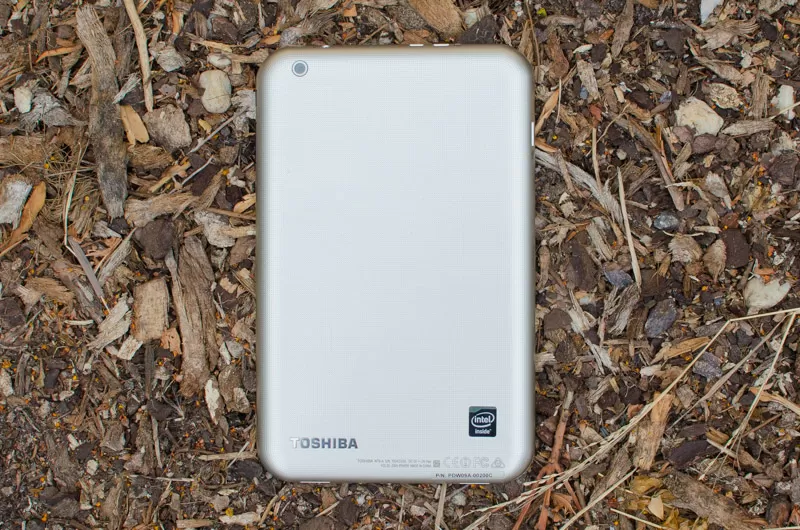
The Encore is a fairly chubby device, making no attempt to match the svelte nature of some of its competitors. Its 10.7mm thick and 445 grams heavy profile compares unfavorably to the Lenovo Miix 2 8 (at 350g and 8.35mm thick) and to the highly popular Apple iPad mini Retina (308g/7.5mm). The size doesn't just look bad on paper, the Encore feels portly in your hands and the design doesn’t try to hide it.
Compounding the issue is the sizable bezel around the display. To either side of the panel is 14mm of plastic and glass, which makes the tablet feel just slightly wider than what would normally be comfortable. Display coverage is just under 65%, although the device is still quite portable overall, significantly more so than a 10-inch device.
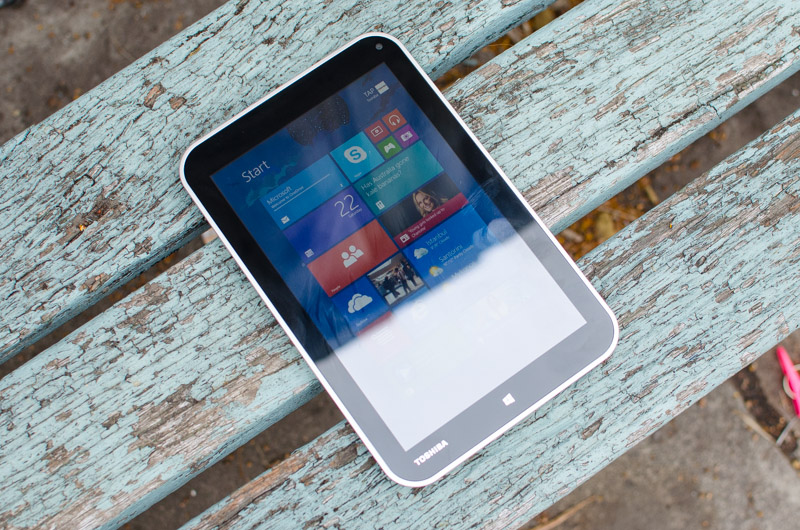

Apart from the glass protecting the display, the rest of the Encore is made from plastic that wraps right around the tablet, providing a rim around the front panel. The plastic in no way gives the tablet a premium feel, despite the square pattern that’s used on the back (also only available in silver).
Like most other eight inchers, everything is positioned so that portrait is the default orientation. Most aspects of the design are extremely minimalist: the front has a small piece of branding plus a Windows button and front facing camera to the far right; whereas the back features a Toshiba logo along the bottom, an Intel Inside sticker that looks somewhat out of place, and a rear facing camera in the top left.
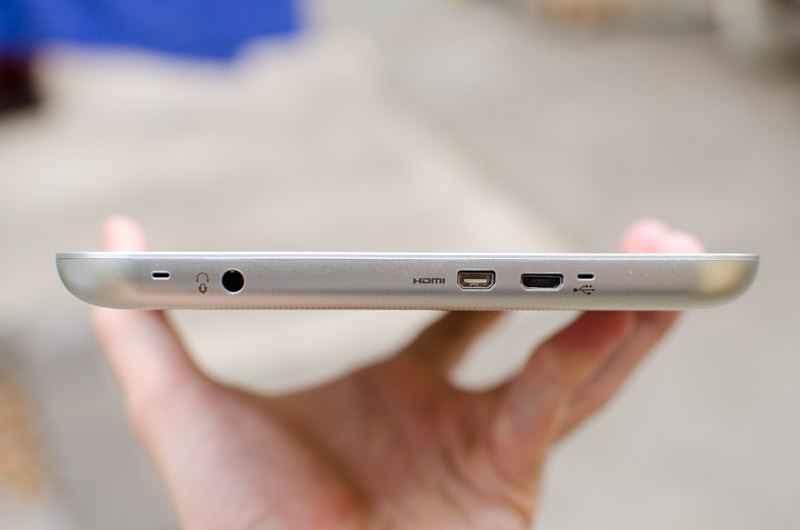


On the bottom edge you’ll find the tablet’s dual speakers. In our tests these didn't perform well at high volumes but are certainly usable for casual listening. The right edge has the fairly weak-feeling power button and volume rocker, and the left side has an exposed microSD card slot. All the ports for the device are along the top edge, such as the 3.5mm audio jack, microUSB port and micro-HDMI port, the latter of which some may find especially useful if they want to frequently use external displays.
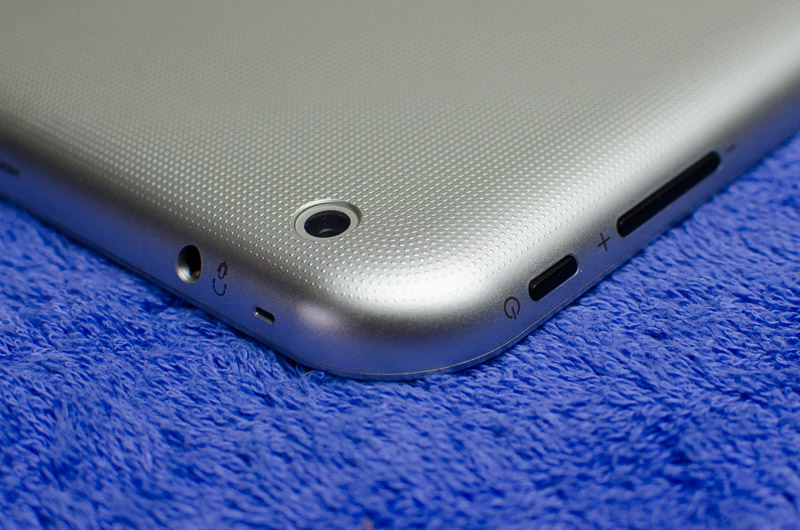
The design of the Toshiba Encore doesn’t stop you from enjoying the hardware in the device, but it definitely lacks a spark that would make it a more attractive offering. With an 8-inch display the tablet is portable, however it’s neither as slim nor as light as some of its competitors.
I’m not particularly happy with the resolution of this 8-inch display when other sub-$300 tablets manage to include 1080p panels. Individual pixels are reasonably noticeable (189 PPI) especially along the edges of text, but also when looking at photos and videos.
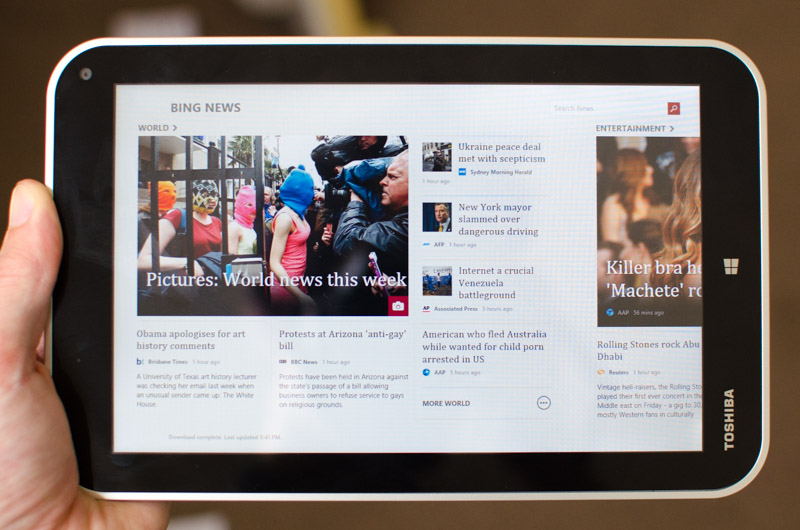
The panel is capable of displaying 720p videos natively, while all 1080p content will be downscaled to 720p.
This is not to say the Encore’s panel is completely unusable. WXGA is fine for everyday tasks, as has been the case for many years, but over the past 12 months it has been quickly superseded by lower-cost high-density displays. When Asus can produce a 7-inch tablet with a 1080p display for a little over $200, and Amazon can do the same at 8.9-inches, the Toshiba Encore seems behind the times.
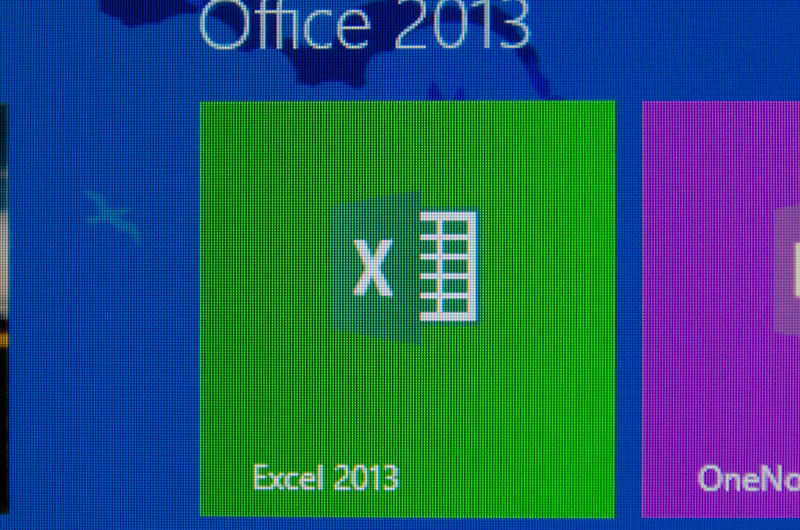
Aside from screen resolution the overall color quality is average, especially in terms of saturation, which is noticeably lacking compared to IPS LCDs. The panel’s contrast is good, although there is backlight bleed when viewing dark images, and a minor amount of color banding when viewing gradients.
One area the Encore’s display really excels is viewing angles. Like an IPS panel, the Encore’s LCD is viewable at nearly all angles, however there is noticeably less color shifting and distortion. This is actually surprising considering there is a decent gap between the protective glass and panel itself, which in TN panels would significantly affect viewing angles.
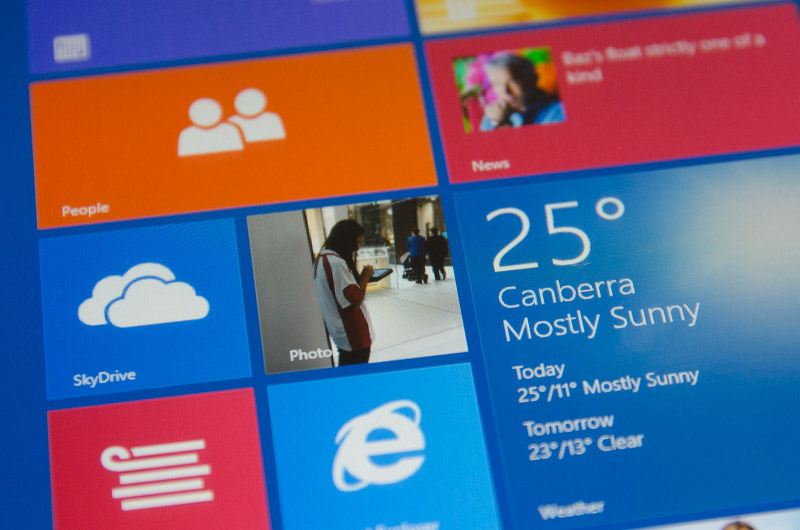
The gap does manage to affect the panel’s reflectivity, which can make the display a little tricky to view in bright settings. Maximum brightness from the LED backlighting is very good, which negates some of the reflectivity issues, and there’s a wide range of brightness levels to make use of. The well-hidden photodetector provides accurate automatic brightness, although it can be somewhat slow to adjust.
Toshiba Encore - $280 - $350
When it comes to 8-inch Windows tablets, the release of Windows 8.1
has seen many companies try their hands at crafting the perfect tablet.
Acer was first with the mediocre Iconia W3
and shortly afterwards a ton of other devices came to the market from
the likes of Dell, Asus, Lenovo and also Toshiba, whose 'Encore' tablet
is the focus of today’s review.- 8.0”, 1280x720 HFFS LCD (189 ppi)
- Intel Bay Trail Z3740 SoC
- 1.3 GHz quad-core CPU, HD Graphics GPU, 2GB RAM
- 32 or 64 GB internal storage, microSD card slot
- 8 MP camera, 1/3.2” sensor, f/2.2 lens
- Wi-Fi a/b/g/n, Bluetooth 4.0, 19.5 Wh battery
- Windows 8.1 + Microsoft Office
- 445 grams, 10.7mm thick
Like a lot of small Windows tablets in the same price bracket as the Encore, specifications aren’t stellar especially in the display department: we’re looking at a 1280 x 800 panel, a resolution which Windows device manufacturers seem to love. There’s also the popular Intel Atom Z3740 SoC inside, as well as an 8-megapixel camera and 19.5 Wh battery, which makes its hardware package overall a little different to the Lenovo Miix 2 8, which we're also in the process of reviewing.
Design
Most eight inch tablets feature some form of the standard, slightly-rounded rectangular prism design. The Toshiba Encore is no exception, although its take on the slate design is rather uninspiring.
The Encore is a fairly chubby device, making no attempt to match the svelte nature of some of its competitors. Its 10.7mm thick and 445 grams heavy profile compares unfavorably to the Lenovo Miix 2 8 (at 350g and 8.35mm thick) and to the highly popular Apple iPad mini Retina (308g/7.5mm). The size doesn't just look bad on paper, the Encore feels portly in your hands and the design doesn’t try to hide it.
Compounding the issue is the sizable bezel around the display. To either side of the panel is 14mm of plastic and glass, which makes the tablet feel just slightly wider than what would normally be comfortable. Display coverage is just under 65%, although the device is still quite portable overall, significantly more so than a 10-inch device.


Apart from the glass protecting the display, the rest of the Encore is made from plastic that wraps right around the tablet, providing a rim around the front panel. The plastic in no way gives the tablet a premium feel, despite the square pattern that’s used on the back (also only available in silver).
Like most other eight inchers, everything is positioned so that portrait is the default orientation. Most aspects of the design are extremely minimalist: the front has a small piece of branding plus a Windows button and front facing camera to the far right; whereas the back features a Toshiba logo along the bottom, an Intel Inside sticker that looks somewhat out of place, and a rear facing camera in the top left.



On the bottom edge you’ll find the tablet’s dual speakers. In our tests these didn't perform well at high volumes but are certainly usable for casual listening. The right edge has the fairly weak-feeling power button and volume rocker, and the left side has an exposed microSD card slot. All the ports for the device are along the top edge, such as the 3.5mm audio jack, microUSB port and micro-HDMI port, the latter of which some may find especially useful if they want to frequently use external displays.

The design of the Toshiba Encore doesn’t stop you from enjoying the hardware in the device, but it definitely lacks a spark that would make it a more attractive offering. With an 8-inch display the tablet is portable, however it’s neither as slim nor as light as some of its competitors.
Display
Toshiba has gone for an 8.0-inch TFT HFFS LED-backlit LCD panel in the Encore, with a resolution of 1280 x 800. HFFS, which stands for high-transmittance fringe field switching, is an alternate display technology to IPS that offers less color shifting and similar viewing angles. It’s not a display type we often see, but Toshiba might have chosen it to keep manufacturing costs down.I’m not particularly happy with the resolution of this 8-inch display when other sub-$300 tablets manage to include 1080p panels. Individual pixels are reasonably noticeable (189 PPI) especially along the edges of text, but also when looking at photos and videos.

The panel is capable of displaying 720p videos natively, while all 1080p content will be downscaled to 720p.
This is not to say the Encore’s panel is completely unusable. WXGA is fine for everyday tasks, as has been the case for many years, but over the past 12 months it has been quickly superseded by lower-cost high-density displays. When Asus can produce a 7-inch tablet with a 1080p display for a little over $200, and Amazon can do the same at 8.9-inches, the Toshiba Encore seems behind the times.

Aside from screen resolution the overall color quality is average, especially in terms of saturation, which is noticeably lacking compared to IPS LCDs. The panel’s contrast is good, although there is backlight bleed when viewing dark images, and a minor amount of color banding when viewing gradients.
One area the Encore’s display really excels is viewing angles. Like an IPS panel, the Encore’s LCD is viewable at nearly all angles, however there is noticeably less color shifting and distortion. This is actually surprising considering there is a decent gap between the protective glass and panel itself, which in TN panels would significantly affect viewing angles.

The gap does manage to affect the panel’s reflectivity, which can make the display a little tricky to view in bright settings. Maximum brightness from the LED backlighting is very good, which negates some of the reflectivity issues, and there’s a wide range of brightness levels to make use of. The well-hidden photodetector provides accurate automatic brightness, although it can be somewhat slow to adjust.
Performance: Intel Bay Trail Atom Z3740
Inside the Toshiba Encore is Intel’s ‘Bay Trail’ Atom Z3740 SoC, a
very popular choice among manufacturers building mid-range and
entry-level Windows tablets. The very same SoC is seen in the Asus Transformer Book T100 and Lenovo Miix 2 8, so the performance from the Encore should largely be the same as these devices.
CPU-wise we’re looking at four 1.33 GHz ‘Silvermont’ cores, with a Turbo Boost of 1.86 GHz when higher single-thread performance is needed. There’s an Intel Gen 7 HD Graphics GPU clocked at 667 MHz, plus a dual-channel LPDDR3 controller that’s paired with 2 GB of 1067 MHz RAM. Bluetooth 4.0 and dual-band Wi-Fi 802.11a/b/g/n make up the tablet’s connectivity; there’s no LTE/HSPA+ model available, which some users will find disappointing.
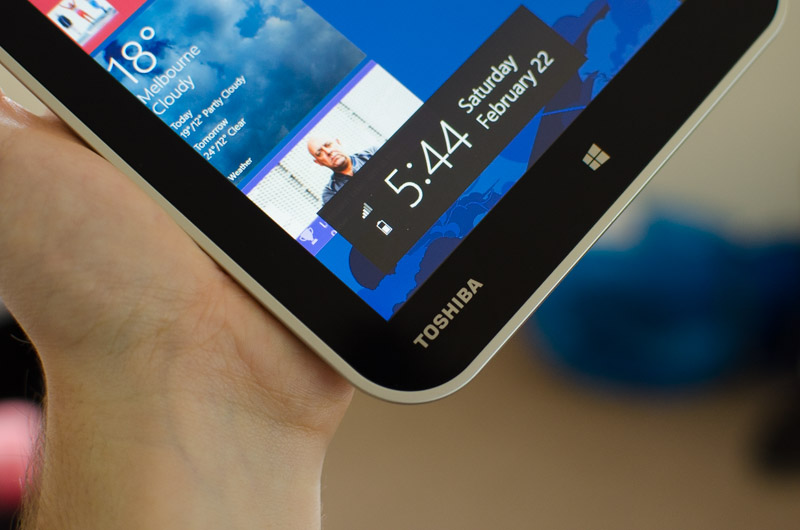
General performance around the operating system is very good. All animations are fluid thanks to hardware acceleration, and loading Modern apps is reasonably fast. The included 2 GB of RAM is standard in tablets now, and as you’d expect it allows the device to multitask with little effort. Using the browser is also quick when manipulating and loading webpages, not as quick as a high-end Intel ‘Haswell’ processor, but on-par with ARM-based devices.
Windows 8.1 will give you access to the full desktop on the Toshiba Encore, and you’ll easily be able to use non-intensive applications such as Microsoft Office, VLC, Spotify and the included Windows Explorer. However the Atom SoC is definitely unsuitable for more professional tasks, such as using Photoshop or rendering in 3ds Max.
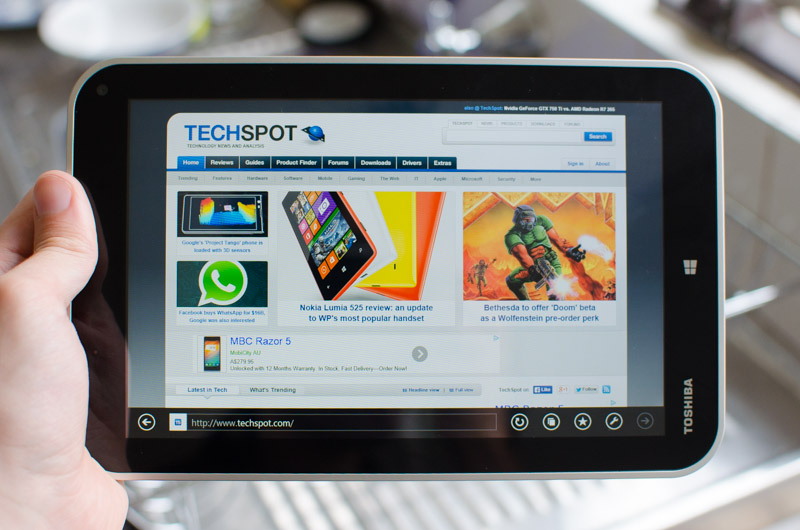
There are a few performance hiccups along the way. From time to time the power button would become completely unresponsive, making it impossible to wake up the device, and at other times the Windows button wouldn’t work. There were also a few occasions where an application I was using crashed, or simply refused to load at all. Hopefully we’ll see these minor annoyances fixed through a software update.
The Encore won’t struggle with games available through the Windows Store, as Intel’s seventh-generation HD Graphics GPU – a low-power version of the GPU found in their ‘Ivy Bridge’ processors – is always up to the task. The GPU only needs to render to a 1280 x 800 display, so you might find that some older Steam games will also work on the Toshiba Encore, provided you connect a keyboard and mouse.
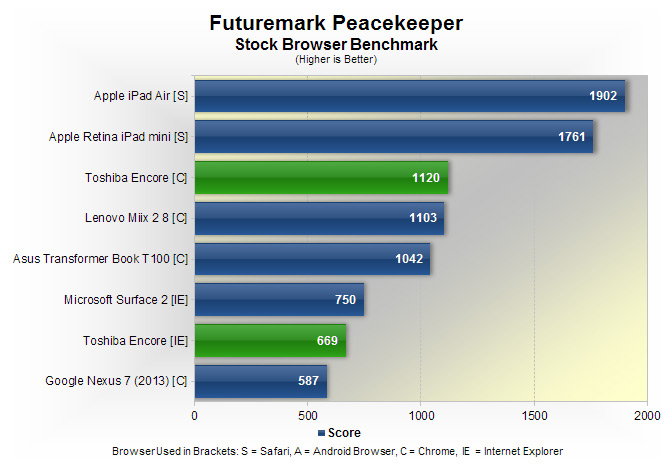
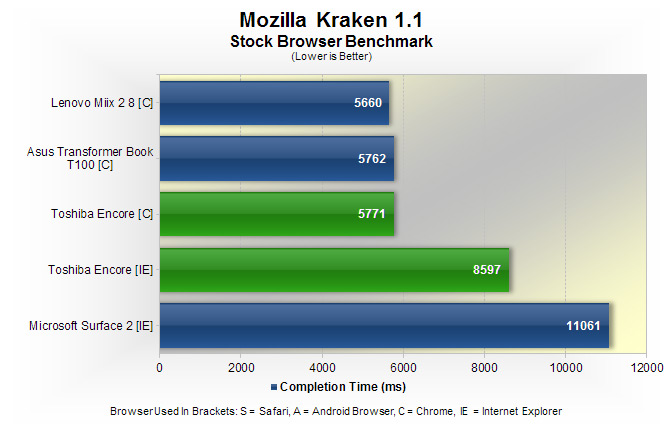 When it comes to benchmarks, the Encore performs as expected. The Bay
Trail SoC is a strong performer in CPU-bound tasks, both
single-threaded and multi-threaded, despite what may seem to be low
clock speeds. I’d have liked to see the Z3770 here to squeeze out a bit
more performance, but the Z3740 is still a good choice.
When it comes to benchmarks, the Encore performs as expected. The Bay
Trail SoC is a strong performer in CPU-bound tasks, both
single-threaded and multi-threaded, despite what may seem to be low
clock speeds. I’d have liked to see the Z3770 here to squeeze out a bit
more performance, but the Z3740 is still a good choice.
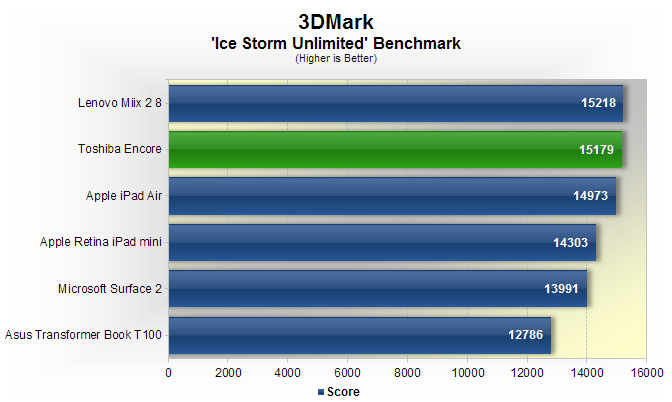
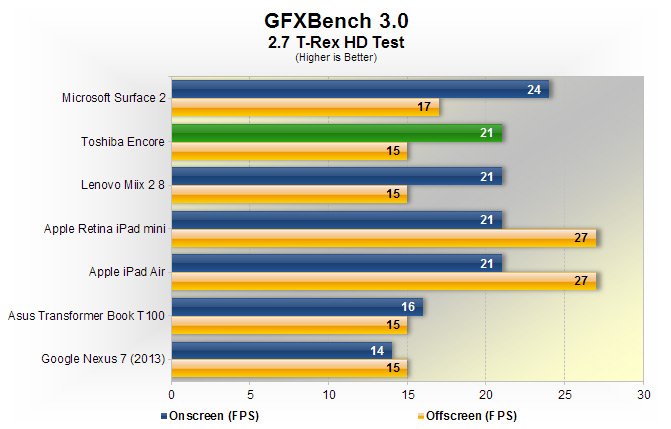 Intel isn’t known for their fantastic graphics cores, but the HD
Graphics unit in this SoC is a decent performer. It’s not at the same
level as the Adreno 330 in Qualcomm’s Snapdragon 800, or the PowerVR
G6430 in the Apple A7, but at lower resolutions like you’ll see on the
Encore, it doesn’t disappoint.
Intel isn’t known for their fantastic graphics cores, but the HD
Graphics unit in this SoC is a decent performer. It’s not at the same
level as the Adreno 330 in Qualcomm’s Snapdragon 800, or the PowerVR
G6430 in the Apple A7, but at lower resolutions like you’ll see on the
Encore, it doesn’t disappoint.
The Encore is available in two models, 32 GB and 64 GB, both of which come with a microSD card slot for expanding storage. Our 64 GB review unit is formatted with 52.7 GB of space, of which around 40 GB is user accessible out of the box. This is more than enough to store a range of apps plus some local media, and a better choice compared to the 32 GB, which will be restricted as Windows 8.1 requires a lot of space.
There doesn't appear to be any issues with the Bluetooth or Wi-Fi performance of the Toshiba Encore. I easily managed to transfer data on both my 2.4 GHz and 5 GHz 802.11n networks at over 18 MB/s. Admittedly it doesn’t have the latest Wi-Fi technology (802.11ac), but routers packing this tech are yet to become widespread.
CPU-wise we’re looking at four 1.33 GHz ‘Silvermont’ cores, with a Turbo Boost of 1.86 GHz when higher single-thread performance is needed. There’s an Intel Gen 7 HD Graphics GPU clocked at 667 MHz, plus a dual-channel LPDDR3 controller that’s paired with 2 GB of 1067 MHz RAM. Bluetooth 4.0 and dual-band Wi-Fi 802.11a/b/g/n make up the tablet’s connectivity; there’s no LTE/HSPA+ model available, which some users will find disappointing.

General performance around the operating system is very good. All animations are fluid thanks to hardware acceleration, and loading Modern apps is reasonably fast. The included 2 GB of RAM is standard in tablets now, and as you’d expect it allows the device to multitask with little effort. Using the browser is also quick when manipulating and loading webpages, not as quick as a high-end Intel ‘Haswell’ processor, but on-par with ARM-based devices.
Windows 8.1 will give you access to the full desktop on the Toshiba Encore, and you’ll easily be able to use non-intensive applications such as Microsoft Office, VLC, Spotify and the included Windows Explorer. However the Atom SoC is definitely unsuitable for more professional tasks, such as using Photoshop or rendering in 3ds Max.

There are a few performance hiccups along the way. From time to time the power button would become completely unresponsive, making it impossible to wake up the device, and at other times the Windows button wouldn’t work. There were also a few occasions where an application I was using crashed, or simply refused to load at all. Hopefully we’ll see these minor annoyances fixed through a software update.
The Encore won’t struggle with games available through the Windows Store, as Intel’s seventh-generation HD Graphics GPU – a low-power version of the GPU found in their ‘Ivy Bridge’ processors – is always up to the task. The GPU only needs to render to a 1280 x 800 display, so you might find that some older Steam games will also work on the Toshiba Encore, provided you connect a keyboard and mouse.




The Encore is available in two models, 32 GB and 64 GB, both of which come with a microSD card slot for expanding storage. Our 64 GB review unit is formatted with 52.7 GB of space, of which around 40 GB is user accessible out of the box. This is more than enough to store a range of apps plus some local media, and a better choice compared to the 32 GB, which will be restricted as Windows 8.1 requires a lot of space.
There doesn't appear to be any issues with the Bluetooth or Wi-Fi performance of the Toshiba Encore. I easily managed to transfer data on both my 2.4 GHz and 5 GHz 802.11n networks at over 18 MB/s. Admittedly it doesn’t have the latest Wi-Fi technology (802.11ac), but routers packing this tech are yet to become widespread.

No comments:
Write comments